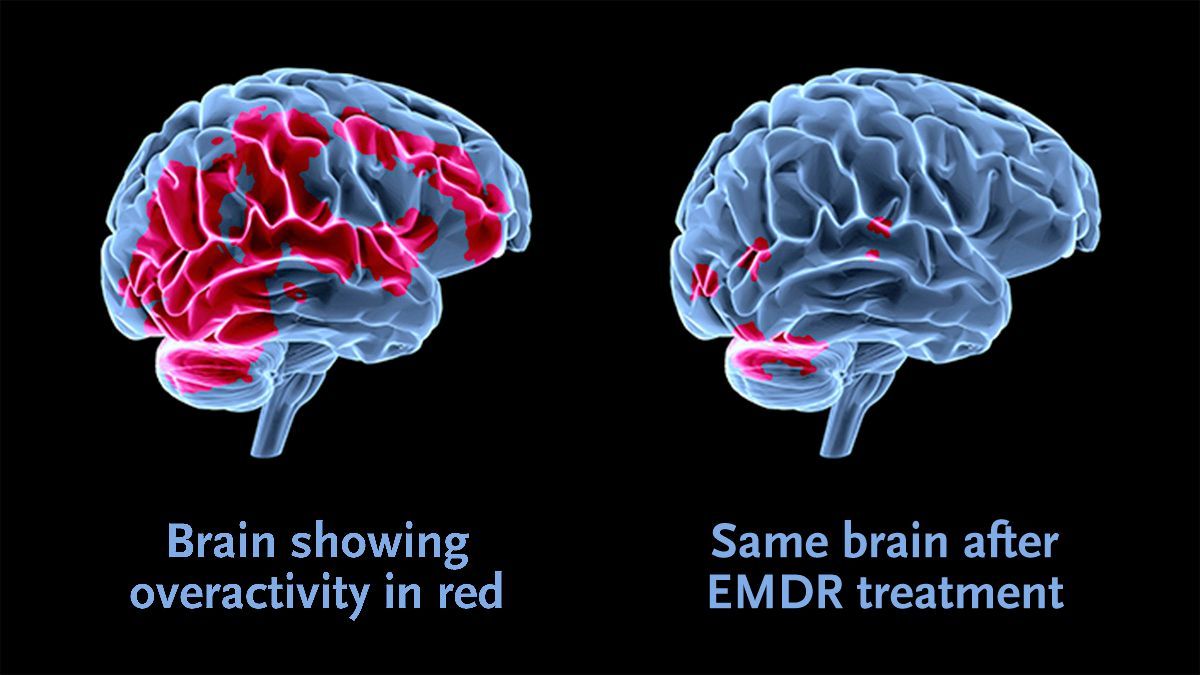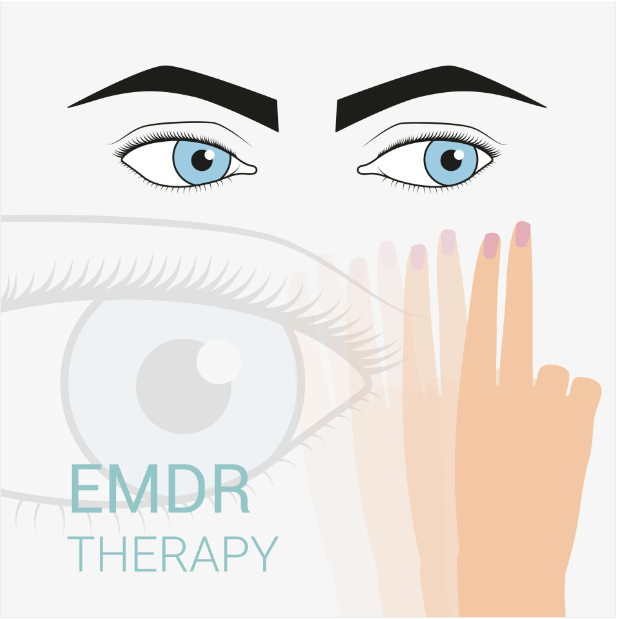Understanding EMDR Therapy: A Guide to Healing Trauma
How EMDR Therapy Works for Trauma
Have you ever experienced a traumatic event that continues to haunt you, even long after it's over? Trauma can have a profound impact on our mental health, often leading to symptoms such as anxiety, panic attacks, and post-traumatic stress disorder (PTSD). Fortunately, there are effective treatments available, one of which is eye movement desensitization and reprocessing (EMDR) therapy. In this blog, we'll explore how EMDR therapy works for trauma and its potential benefits in promoting healing and recovery.
Understanding EMDR Therapy
Before delving into the details, let's first understand what EMDR therapy is all about. EMDR therapy is a psychotherapy approach that was developed by Francine Shapiro in the late 1980s. It focuses on targeting traumatic memories and disturbing events that contribute to mental health conditions such as PTSD. At its core, EMDR therapy involves bilateral stimulation, which can be achieved through eye movement, sounds, or taps. This bilateral stimulation helps desensitize distressing memories and reprocess them into more positive beliefs, ultimately leading to emotional healing and relief from trauma-related symptoms.
Origin and Purpose of EMDR Therapy
EMDR therapy was pioneered by Francine Shapiro, who discovered its effectiveness while walking in the park and noticing her distressing thoughts diminishing while her eyes moved rapidly. Inspired by this experience, she began researching and developing what is now known as EMDR therapy. Since then, EMDR therapy has gained recognition as an effective treatment for trauma and various mental health conditions.
The primary purpose of EMDR therapy is to target traumatic experiences and disturbing memories that contribute to psychological distress. By reprocessing these memories through bilateral stimulation, EMDR therapy aims to desensitize the distressing emotions, beliefs, and physical sensations associated with trauma. This process helps individuals develop new, adaptive ways of processing traumatic events, leading to improved mental health and overall well-being.
Key Concepts of EMDR Therapy
To fully understand EMDR therapy, it's important to explore its key concepts and principles. One of the fundamental concepts of EMDR therapy is adaptive information processing, which refers to the brain's innate ability to process and integrate experiences in a healthy way. When a traumatic event occurs, the information processing system of the brain becomes overwhelmed, leading to the formation of distressing memories and negative beliefs.
EMDR therapy aims to target this disturbing event and reprocess it, allowing the brain to integrate the information in a healthier manner. Through bilateral stimulation, the therapy helps individuals process and desensitize traumatic memories, reducing the emotional distress associated with them. As the distressing memories are desensitized, positive beliefs are installed, promoting emotional healing, and a sense of empowerment.
During EMDR therapy, the therapist guides the individual through specific target memories, assisting them in identifying negative beliefs associated with the trauma. These negative beliefs are then replaced with positive beliefs, fostering adaptive cognition and promoting emotional well-being. This process of targeted memory processing and positive belief installation assists individuals in developing new ways of perceiving themselves and their trauma, ultimately leading to healing and recovery.
The Process of EMDR Therapy
Now that we have an understanding of the key concepts of EMDR therapy, let's take a closer look at the process of this treatment. EMDR therapy typically consists of several treatment phases, each designed to address different aspects of trauma processing and healing. These phases work together to create a comprehensive and structured approach to tackling traumatic memories and their associated distressing emotions.
Initial Phases of EMDR Therapy
The initial phases of EMDR therapy focus on assessment and treatment planning to establish a foundation for therapy. During the assessment phase, the therapist collaborates with the individual to identify target memories and negative beliefs related to traumatic experiences. This process helps determine the specific areas that need to be addressed in therapy sessions.
In addition, treatment planning is an important aspect of the initial phases of EMDR therapy. The therapist works with the individual to create a roadmap for treatment, setting goals and identifying the most appropriate strategies and techniques to be used. This stage is crucial, as it ensures that therapy sessions are tailored to the unique needs of the individual, maximizing the effectiveness of EMDR therapy.
Treatment and Processing Phases of EMDR Therapy
Once the assessment and treatment planning stages are complete, the treatment and processing phases of EMDR therapy begin. These phases involve working directly with the traumatic memories and desensitizing them to reduce emotional distress.
The desensitization phase of EMDR therapy focuses on processing specific target memories. The therapist facilitates bilateral stimulation, which can be eye movement, taps, or sounds, while the individual mentally focuses on the traumatic memory. This bilateral stimulation helps stimulate both sides of the brain, aiding in the reprocessing of the distressing memory.
During this phase, the therapist guides the individual through the memory, addressing any negative thoughts, emotions, or physical sensations associated with it. The goal is to desensitize the traumatic memory, reducing its emotional impact and facilitating adaptive information processing. As the distressing memory is desensitized, new, positive beliefs are installed, replacing negative beliefs and promoting emotional healing.
In some cases, a body scan may be incorporated during the desensitization phase of EMDR therapy. This involves focusing on physical sensations and emotions that arise while processing the traumatic memory. By addressing these physical sensations, therapists and individuals can uncover deeper layers of trauma and work towards processing and resolving them.
Throughout the treatment and processing phases of EMDR therapy, the therapist and individual work together to address each target memory in a systematic and comprehensive manner. This process helps desensitize the distressing memories, reducing emotional distress, and promoting adaptive information processing.


Closure and Re-evaluation Phases of EMDR Therapy
As the treatment and processing phases of EMDR therapy progress, the closure and re-evaluation phases come into play. The closure phase is typically conducted at the end of each therapy session, ensuring emotional stability before concluding the session. This phase involves techniques aimed at bringing the therapy session to a positive and calming conclusion, ensuring that the individual feels safe and grounded after processing distressing memories.
During the closure phase, the therapist may employ relaxation techniques, such as deep breathing or guided imagery, to help the individual find a sense of calm and relaxation. This phase also allows time for reflection and debriefing, addressing any emotions or thoughts that may have surfaced during the therapy session. By providing closure, this phase helps individuals transition back to their daily lives, feeling supported and empowered.
In addition to the closure phase, re-evaluation plays an important role in the overall process of EMDR therapy. After each session, the therapist and individual assess the progress and impact of the treatment. This evaluation allows for feedback and adjustments, ensuring that therapy sessions remain focused on the individual's specific needs and goals. By continuously re-evaluating the efficacy of previous sessions, the therapist can make informed decisions about the next session, maximizing the positive effect of EMDR therapy.
Conditions Treated by EMDR Therapy
EMDR therapy has shown promise in treating a range of mental health conditions, particularly those stemming from traumatic experiences. Two common conditions that EMDR therapy is often used to address are post-traumatic stress disorder (PTSD) and anxiety disorders.
EMDR for Post-Traumatic Stress Disorder (PTSD)
Perhaps one of the most well-known and extensively studied applications of EMDR therapy is in the treatment of post-traumatic stress disorder (PTSD). PTSD is a mental health condition that can develop after experiencing a traumatic event, and it is characterized by symptoms such as flashbacks, nightmares, avoidance, and hypervigilance.
EMDR therapy offers a systematic and effective approach to alleviating symptoms of PTSD and processing traumatic memories. By targeting specific traumatic memories, the therapy desensitizes the distressing emotions, negative beliefs, and physical sensations associated with them, leading to emotional healing and resolution of trauma-related symptoms.
Numerous research studies have demonstrated the efficacy of EMDR therapy in the treatment of PTSD. Organizations such as the Department of Veterans Affairs, the World Health Organization, and the American Psychological Association recognize EMDR therapy as a valid treatment option for PTSD. The structured nature of EMDR therapy, combined with the targeted memory processing and belief installation, has been shown to bring about significant improvements in PTSD symptoms, resulting in a better quality of life for individuals affected by this condition.


EMDR for Anxiety and Panic Disorders
In addition to its effectiveness in treating PTSD, EMDR therapy has also proven beneficial in addressing anxiety disorders, including panic disorder and specific phobias. Anxiety disorders are characterized by excessive and persistent worry, fear, and panic attacks that can significantly impact an individual's daily life.
EMDR therapy specifically targets traumatic experiences and negative beliefs associated with anxiety disorders, helping to reprocess distressing memories and emotions. By desensitizing these memories, EMDR therapy reduces anxiety symptoms, such as panic attacks, irrational fears, and avoidance behaviors.
The therapy process involves working through anxiety-provoking memories, desensitizing the distressing emotions and physical sensations, and installing positive beliefs related to coping and resilience. This targeted memory processing, combined with bilateral stimulation, promotes adaptive information processing, leading to a reduction in anxiety symptoms and an overall improvement in mental well-being.
It's important to note that EMDR therapy for anxiety disorders is most effective when conducted by a trained EMDR therapist who can tailor the treatment to address the individual's specific symptoms and experiences. Through the systematic and structured approach of EMDR therapy, individuals with anxiety disorders can find relief from distressing symptoms, gaining a new perspective on themselves and their ability to cope with anxiety-inducing situations.
Effectiveness of EMDR Therapy
Research studies have consistently shown the efficacy of EMDR therapy in promoting healing and recovery from trauma-related conditions. These studies provide empirical evidence of the positive outcomes associated with EMDR therapy, further validating its effectiveness in the mental health field.
What Does the Research Say About EMDR?
Numerous research studies have demonstrated the effectiveness of EMDR therapy in treating trauma-related conditions. For example, a systematic review conducted by the World Health Organization found that EMDR therapy is effective for treating symptoms of trauma and stress-related disorders.
Similarly, the Department of Defense, which has extensively studied trauma treatment, recognizes EMDR therapy as an evidence-based treatment for PTSD. Their research findings support the efficacy of EMDR therapy in reducing symptoms of trauma and improving overall mental health outcomes.
These research studies provide robust evidence of the positive impact of EMDR therapy on trauma-related symptoms, including those associated with PTSD and anxiety disorders. The recognition of EMDR therapy by reputable organizations further solidifies its validity as an effective treatment option, offering hope and healing to individuals experiencing the debilitating effects of trauma.
Personal Experiences with EMDR Therapy
Beyond the research studies, numerous personal accounts and testimonials highlight the transformative effects of EMDR therapy on trauma symptoms and mental well-being. Individuals who have undergone EMDR therapy often share their experiences of emotional healing, improved coping mechanisms, and resolution of traumatic memories.
Many individuals report a significant reduction in the distressing symptoms associated with trauma, such as nightmares, flashbacks, and anxiety. They describe how EMDR therapy helped them gain a new perspective on their traumatic experiences, allowing them to process and integrate the memories in a healthier way.
Personal accounts of EMDR therapy often emphasize the profound impact it has had on their mental health, overall quality of life, and relationships. Through the targeted memory processing and positive belief installation, individuals experience a sense of empowerment, resilience, and emotional healing. These personal testimonials serve as a testament to the effectiveness of EMDR therapy in helping individuals overcome the traumatic impact of distressing memories.


Preparing for EMDR Therapy
If you're considering EMDR therapy, it's important to know what to expect and how to prepare for your first session. The initial session of EMDR therapy is typically used for assessment and treatment planning, where you and your therapist will discuss your treatment goals and develop a plan that suits your specific needs.
What to Know Before Your First EMDR Session
Before your first EMDR session, it's crucial to have an initial consultation with your therapist, during which you can discuss your expectations, treatment goals, and any concerns you may have. This consultation helps both you and your therapist establish a rapport and ensure that EMDR therapy is the right approach for your needs.
During your therapy sessions, you can expect to work through targeted traumatic memories and process the associated emotions, thoughts, and physical sensations. It's important to have realistic expectations and understand that EMDR therapy may bring up intense emotions or temporary discomfort as you work through the trauma. Your therapist will provide support and guidance throughout the process, ensuring a safe and nurturing environment for your healing journey.
How to Find an EMDR-trained Clinician
Finding a qualified and experienced EMDR-trained clinician is essential for receiving effective EMDR therapy. To find an EMDR therapist, you can start by researching mental health professionals in your area who specialize in trauma treatment. The EMDR International Association also provides a directory of certified EMDR therapists, making it easier to find qualified clinicians.
When selecting an EMDR therapist, it's important to inquire about their experience and training in EMDR therapy. Consider reaching out to trusted sources, such as your primary care physician or mental health organizations, for recommendations. Additionally, check with your health care provider to determine if EMDR therapy is covered by your insurance plan, as this can influence your choice of therapist.
We provide EMDR treatment at Healing Our Trauma. Click here to learn more: EMDR Therapy at Healing Our Trauma.


Pros and Cons of EMDR Therapy
As with any therapy approach, it's important to consider both the benefits and potential limitations of EMDR therapy. EMDR therapy offers several advantages for trauma processing and healing, but it may not be suitable for everyone or every situation.
Benefits of EMDR Therapy for Trauma
One of the key benefits of EMDR therapy for trauma is its ability to desensitize distressing memories and promote emotional healing. Through targeted memory processing and positive belief installation, individuals experience a reduction in trauma-related symptoms, improved mental health, and an overall sense of well-being.
EMDR therapy has been effective in helping individuals process traumatic experiences, leading to relief from distressing emotions, negative beliefs, and physical sensations. The therapy process aims to rewire the way traumatic memories are stored, fostering adaptive information processing, and challenging debilitating thoughts associated with trauma.
Research studies and personal accounts highlight the positive effects of EMDR therapy, including reduced symptoms of trauma, improved emotional regulation, and enhanced coping mechanisms. By processing traumatic memories, individuals experience a shift in their perception of themselves, their trauma, and the world around them, resulting in lasting positive changes in mental health and overall quality of life.
Limitations and Considerations of EMDR Therapy
While EMDR therapy has shown great efficacy, it's important to consider certain limitations and individual considerations when deciding if this therapy is right for you. EMDR therapy may not be suitable for individuals who are currently experiencing severe emotional distress or instability, as the process of desensitizing traumatic memories can temporarily intensify emotions.
Additionally, some mental health conditions require specialized treatment approaches, and EMDR therapy may not be the most appropriate treatment modality in these cases. It is crucial to discuss your specific needs, concerns, and mental health history with an EMDR-trained therapist to determine if EMDR therapy aligns with your therapeutic goals.
EMDR Therapy Vs Other Therapies
When exploring treatment options for trauma and mental health conditions, it's important to consider the different therapy approaches available. EMDR therapy offers a distinct approach in comparison to other therapies commonly used in mental health care.
EMDR and Traditional Talk Therapy
Talk therapy, commonly referred to as traditional therapy, involves verbal communication between the therapist and the individual seeking treatment. While talk therapy can be effective in addressing trauma, EMDR therapy offers a unique approach that goes beyond traditional methods of therapy.
EMDR therapy incorporates bilateral stimulation, allowing for targeted memory processing and desensitization of distressing emotions. Traditional talk therapy primarily relies on verbal interaction, whereas EMDR therapy integrates eye movement desensitization and reprocessing to promote adaptive information processing.
Can Online Therapy Complement EMDR Treatment?
In recent years, online therapy has emerged as a convenient and accessible alternative to in-person therapy. When it comes to complementing EMDR treatment, online therapy can offer additional benefits, especially in terms of accessibility and flexibility.
Online therapy platforms provide a virtual space where individuals can engage in therapy sessions from the comfort of their own homes. This can be particularly beneficial for those who have limited access to EMDR-trained clinicians or face barriers, such as transportation or physical limitations.
By incorporating online therapy, individuals can supplement their EMDR treatment by participating in virtual bilateral stimulation sessions, replicating the benefits of in-person therapy. The accessibility of online therapy allows for consistent and effective treatment, ensuring that individuals receive the support they need, regardless of geographical location or physical constraints.
EMDR therapy is a highly effective treatment for trauma that has gained recognition and success in the mental health field. Its unique approach of incorporating bilateral stimulation allows for the reprocessing and desensitization of distressing memories, leading to significant symptom reduction and emotional healing. EMDR therapy has been shown to be particularly beneficial for conditions such as post-traumatic stress disorder (PTSD), anxiety, and panic disorders. While it is important to note that EMDR is not a one-size-fits-all solution, it has proven to be a valuable tool in the therapeutic landscape. As with any form of therapy, it is crucial to find a trained and experienced EMDR clinician who can guide you through the process. Whether in-person or online, EMDR therapy offers hope and healing for those who have experienced trauma, providing a path towards a brighter future.
Recent Posts
Similar Posts
At Healing Our Trauma we know that you want to be on a path to recovery and restoration. In order to do that, you need to address your underlying, unmet needs. The problem is most people don't know where to turn to or how to start which makes you feel frustrated and stuck. This leads some to want to quit. We believe in your resilience and the possibility of reclaiming a life marked by strength, growth, and renewed hope. We understand that overcoming trauma is a journey that requires personalized care, empathy, and a safe space for healing.
So, schedule a free evaluation. And in the meantime, sign-up for our Support Newsletter.
Together, we can navigate this journey toward healing, ensuring that you not only survive but thrive in the aftermath of trauma.
Contact Us
816-200-7909
Contact Us
We will get back to you as soon as possible
Please try again later
Insurance Accepted: Aetna (Missouri Only)
Forms of Payment: Cash, Check, Visa, Mastercard, Discover, American Express
Our address
Email: nadirah@healingtraumakc.com
Tel: 816-200-7909
12401 E 43rd St S, Independence, MO 64055, United States of America
Work Hours
- Mon - Fri
- -
- Sat - Sun
- Closed






